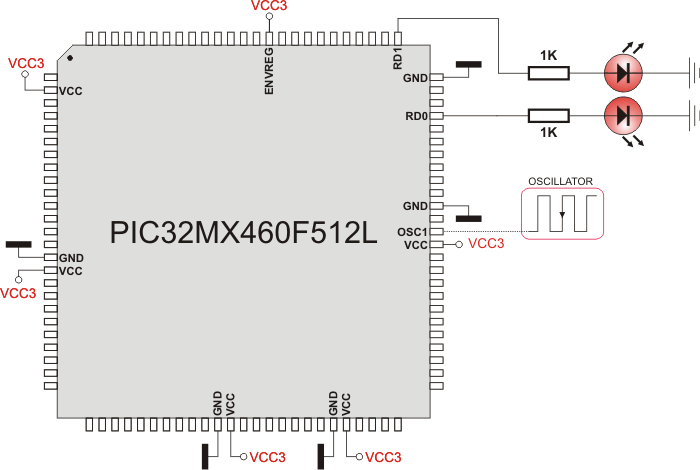PWM Library
The CCP module is available with a number of PIC32 MCUs. mikroBasic PRO for PIC32 provides a library which simplifies using of the PWM HW Module.
 Important :
PWM module uses either Timer2 or Timer3 module.
Important :
PWM module uses either Timer2 or Timer3 module.
Library Routines
PWM_Init
| Prototype |
sub function PWM_Init(dim freq_hz as longword, dim enable_channel_x, timer_prescale, use_timer_x as word) as word |
|---|---|
| Description |
Initializes the PWM module with duty ratio 0. |
| Parameters |
|
| Returns |
|
| Requires |
MCU must have the HW PWM Module. |
| Example |
' Initializes the PWM module at 5KHz, channel 1, no clock prescale, timer2 : dim pwm_period1 as word ... pwm_period1 = PWM_Init(5000, 1, 0, 2) |
| Notes |
Number of available PWM channels depends on MCU. Refer to MCU datasheet for details. |
PWM_Init_Advanced
| Prototype |
sub function PWM_Init_Advanced(dim freq_hz, Fpb_kHz as longword, dim enable_channel_x, timer_prescale, use_timer_x as word) as word |
|---|---|
| Description |
Initializes the PWM module with duty ratio 0. |
| Parameters |
|
| Returns |
|
| Requires |
MCU must have the HW PWM Module. |
| Example |
dim pwm_period1 as word ... pwm_period1 = PWM_Init_Advanced(5000, 50000, 1, 0, 2) |
| Notes |
Number of available PWM channels depends on MCU. Refer to MCU datasheet for details. |
PWM_Set_Duty
| Prototype |
sub procedure PWM_Set_Duty(dim duty, channel as word) |
|---|---|
| Description |
The function changes PWM duty ratio. |
| Parameters |
|
| Returns |
Nothing. |
| Requires |
MCU must have the HW PWM Module. PWM channel must be properly initialized. See PWM_Init routine. |
| Example |
' Set channel 1 duty ratio to 50%: dim pwm_period1 as word ... PWM_Set_Duty(pwm_period1 div 2, 1) |
| Notes |
Number of available PWM channels depends on MCU. Refer to MCU datasheet for details. |
PWM_Start
| Prototype |
sub procedure PWM_Start(dim enable_channel_x as byte) |
|---|---|
| Description |
Starts PWM at requested channel. |
| Parameters |
|
| Returns |
Nothing. |
| Requires |
MCU must have the HW PWM Module. PWM channel must be properly configured. See the PWM_Init and PWM_Set_Duty routines. |
| Example |
' start PWM at channel 1 PWM_Start(1) |
| Notes |
Number of available PWM channels depends on MCU. Refer to MCU datasheet for details. |
PWM_Stop
| Prototype |
sub procedure PWM_Stop(dim disable_channel_x as byte) |
|---|---|
| Description |
Stops PWM at requested channel. |
| Parameters |
|
| Returns |
Nothing. |
| Requires |
MCU must have the HW PWM Module. |
| Example |
' stop PWM at channel 1 PWM_Stop(1) |
| Notes |
Number of available PWM channels depends on MCU. Refer to MCU datasheet for details. |
Library Example
The example changes PWM duty ratio on channels 1 and 2 continuously. If LEDs are connected to channels 1 and 2, a gradual change of emitted light will be noticeable.
program Pwm_Demo
dim current_duty, old_duty, current_duty1, old_duty1 as word
pwm_period1, pwm_period2 as word
sub procedure InitMain()
CHECON = 0x32
AD1PCFG = 0xFFFF ' initialize AN pins as digital
TRISB = 0xFFFF ' configure PORTB pins as input
PORTD = 0 ' set PORTD to 0
TRISD = 0 ' designate PORTD pins as output
end sub
main:
InitMain()
current_duty = 100 ' initial value for current_duty
current_duty1 = 100 ' initial value for current_duty1
pwm_period1 = PWM_Init(5000 , 1, 1, 2)
pwm_period2 = PWM_Init(10000, 2, 1, 3)
PWM_Start(1)
PWM_Start(2)
PWM_Set_Duty(current_duty, 1) ' set current duty for PWM1
PWM_Set_Duty(current_duty1, 2) ' set current duty for PWM2
while (TRUE) ' endless loop
if RB0_bit = 1 then ' button on RB0 pressed
Delay_ms(1)
current_duty = current_duty + 5 ' increment current_duty
if (current_duty > pwm_period1) then ' if we increase current_duty greater then possible pwm_period1 value
current_duty = 0 ' reset current_duty value to zero
end if
PWM_Set_Duty(current_duty, 1) ' set newly acquired duty ratio
end if
if RB1_bit = 1 then ' button on RB1 pressed
Delay_ms(1)
current_duty = current_duty - 5 ' decrement current_duty
if (current_duty > pwm_period1) then ' if we decrease current_duty greater then possible pwm_period1 value (overflow)
current_duty = pwm_period1 ' set current_duty to max possible value
end if
PWM_Set_Duty(current_duty, 1) ' set newly acquired duty ratio
end if
if RB2_bit = 1 then ' button on RB2 pressed
Delay_ms(1)
current_duty1 = current_duty1 + 5 ' increment current_duty1
if (current_duty1 > pwm_period2) then ' if we increase current_duty1 greater then possible pwm_period2 value
current_duty1 = 0 ' reset current_duty1 value to zero
end if
PWM_Set_Duty(current_duty1, 2) ' set newly acquired duty ratio
end if
if RB3_bit = 1 then ' button on RB3 pressed
Delay_ms(1)
current_duty1 = current_duty1 - 5 ' decrement current_duty1
if (current_duty1 > pwm_period2) then ' if we decrease current_duty1 greater then possible pwm_period1 value (overflow)
current_duty1 = pwm_period2 ' set current_duty to max possible value
end if
PWM_Set_Duty(current_duty1, 2)
end if
Delay_ms(1) ' slow down change pace a little
wend
end.
HW Connection

PWM demonstration
What do you think about this topic ? Send us feedback!




